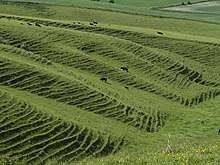Terracette
In geomorphology, a terracette[1] is a type of landform, a ridge on a hillside formed when saturated soil particles expand, then contract as they dry, causing them to move slowly downhill. An example of this is the manger near the Uffington White Horse. It may also be described as a small, irregular step-like formation on steep hillslopes, especially on those used for pasture which are formed by soil creep or erosion of surface soils exacerbated by the trampling of livestock such as sheep or cattle. Synonyms are: catstep[2][3] cattle terracing, sheep or cattle track.

Early investigators believed that animals grazing the hillsides caused them, but further examination revealed places where terracettes abruptly ended at steep rock faces or at soils of different composition. Other sites show livestock trails cutting across terracettes.[4] The conclusion is that although animals may accentuate them, they are not the cause.
See also
References
- "Definition of "terracette" by Patricia Hampl: Home Ground". test.ourhomeground.com. Archived from the original on 2016-04-19. Retrieved 2016-04-29.
- Geology and Ground Water of Yuma County, Co. U. S. Geological Survey. p. J49. Retrieved 14 December 2019.
- Glossary of Landform and Geologic Terms (PDF). U.S. Department of Agriculture. p. 629-79. Retrieved 14 December 2019.
- Buckhouse, John C. "What Caused Those Terracettes?".